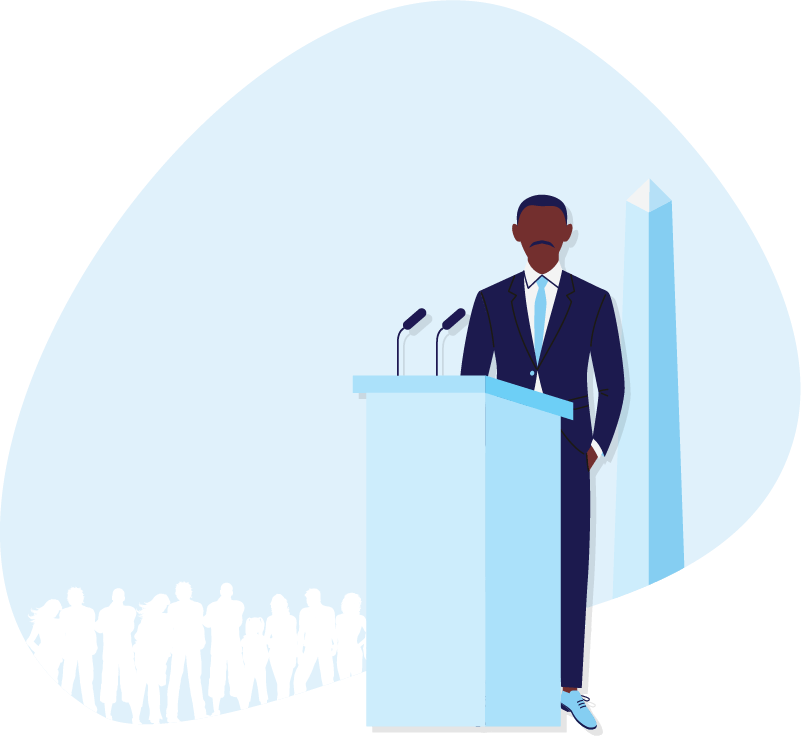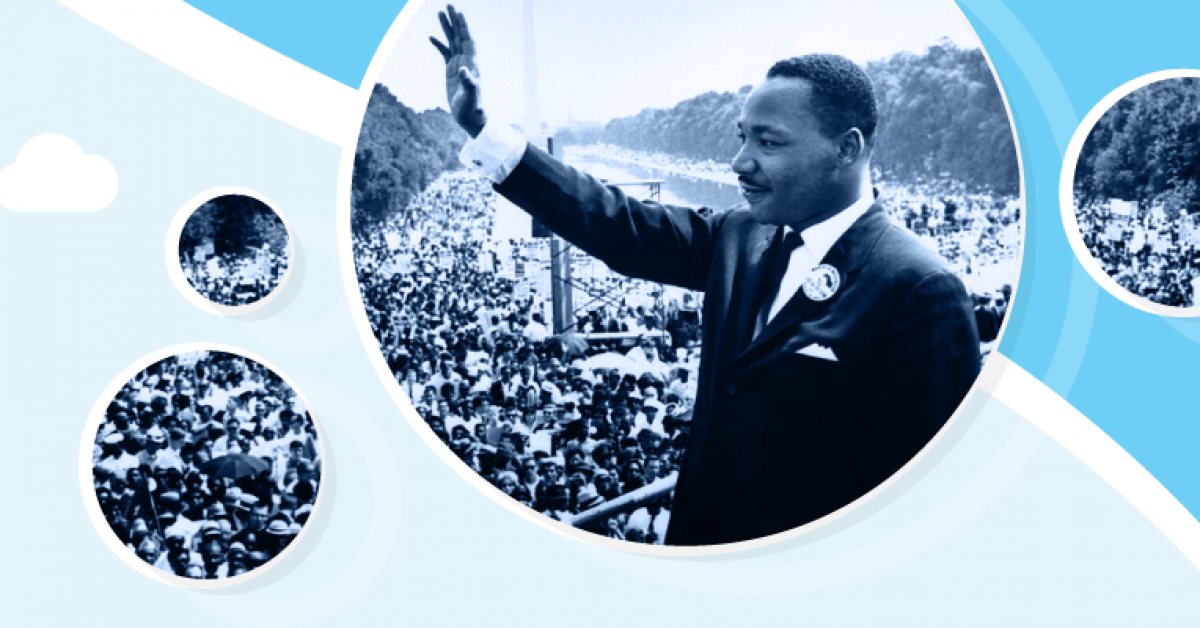“I have a dream” might just be the most quoted line in American history. Delivered by Dr. Martin Luther King, Jr. at the Lincoln Memorial on August 28, 1963, this single sentence marked a defining moment in the Civil Rights Movement and became part of the most iconic speech in American history.
As an activist and Baptist minister, Dr. King knew a thing or two about the importance of communication. As he once said, “People fail to get along because they fear each other; they fear each other because they don’t know each other; they don’t know each other because they have not communicated with each other.”
As we celebrate MLK Day today, let’s take a closer look at what this man — and his speech — can teach us about communication.
Communication Lessons from Martin Luther King, Jr.
1. Convey Conviction
Dr. King’s firm belief in racial equality, civil rights and justice for all was part of what made his speech so powerful. Because he believed in the power of his cause and the beauty of a better future, the crowd of over 250,000 did as well.

Without conviction, any change you’re trying to accomplish will likely fall flat. Whether you’re trying to execute a new strategy, explain a new direction or implement a new program, you need to have confidence in your message. People can sense doubt, so don’t bring uncertainty to the podium.
2. Use Descriptive Language
Dr. King was renowned for his use of language. He didn’t just read off a list of bullet points; he used vivid language to paint a picture of possibility. Take his metaphor for the Declaration of Independence for example: “Instead of honoring this sacred obligation, America has given its colored people a bad check, a check that has come back marked “insufficient funds.” But we refuse to believe that the bank of justice is bankrupt.”
By using descriptive language, metaphors and other figures of speech, you can project your message directly into the minds of your audience. By sparking their imagination, you can make complex topics more digestible. This is an incredibly powerful way to connect your ideas to everyday realities that everyone will understand.
3. Define the Problem
A superhero without a villain is the same as a movement without a goal: purposeless. Without the evil of racial violence and inequality, there would be no reason for Dr. King’s speech. Failing to communicate the problem would have left this speech without a foundation.

In order to unite your audience, you have to call out what they’re fighting against. Without a problem to solve or a common enemy to battle, it’s hard to bring everyone together to share a common goal. Don’t be afraid to define it; there is no light without darkness.
4. Call People to Action
There was a reason all these people were gathered together at the Capital; they were being called to action. To march, to demonstrate, to demand better. Dr. King called for this nation to “rise up and live out the true meaning of its creed: We hold these truths to be self-evident, that all men are created equal.”
There is only one reason for a leader to communicate: to inspire action. But you can’t just hope that it will happen. You need to call upon people to act. This may be the most important part of any message, so make sure it’s clear and motivating.
5. Convey a Sense of Urgency
Dr. King not only called his audience to action; he made it clear that they needed to act immediately. He said, “We have also come to this hallowed spot to remind America of the fierce urgency of now. This is no time to engage in the luxury of cooling off or to take the tranquilizing drug of gradualism. Now is the time to make real the promises of democracy.”

Human beings have a terrible tendency to put things off for as long as we can. You can call people to action until you’re blue in the face, but if you don’t instill a clear sense of urgency, people will often procrastinate until it’s too late.
6. Don’t Shy Away from Repetition
Dr. King was a master at using repetition to build momentum and impact. Like waves crashing on the shore, he would repeat key phrases, building excitement with each iteration. Toward the very end of his speech, he exclaimed, “Let freedom ring from Stone Mountain of Georgia. Let freedom ring from Lookout Mountain of Tennessee. Let freedom ring from every hill and molehill of Mississippi. From every mountainside, let freedom ring.”
While many of us have been taught that repetition in speech can result in monotony, that’s often not the case. Don’t be afraid to repeat key words or phrases to add rhythm and drama to your message. When done right, it’s a very effective way to communicate.
7. Express Empathy
Dr. King knew that his audience needed to be pulled into the story, to be recognized as a part of his movement. He acknowledged, “I am not unmindful that some of you have come here out of great trials and tribulations. Some of you have come fresh from narrow jail cells. And some of you have come from areas where your quest – quest for freedom – left you battered by the storms of persecution and staggered by the winds of police brutality.”
The best way to curry favor with your audience is to express empathy to their struggles. It not only shows that you care about them, but the acknowledgment also serves as an invitation to participate. Your listeners are more likely to feel a part of your story if they recognize themselves in it. Just make sure it’s genuine.
8. Don’t Underestimate the Power of Storytelling
Dr. King was a religious man. He often used parables and anecdotes from the Bible to captivate his audience and convey his message. He knew the value and the power in storytelling. Stories have been around for millennia. Before humans could write, they would pass along their history and morals through storytelling. Even now, we teach children how to behave through stories.

A storytelling leader attracts better talent and sees greater success. A powerful narrative is compelling to people and gives them a sense of purpose. Stories help us connect to people on an emotional level, and connection fosters loyalty. Even if you aren’t a natural-born narrator like Dr. King, storytelling should be a part of your strategy.
9. Follow Before You Lead
MLK knew the value in learning from and working with others. He studied the works of Mahatma Gandhi and Henry David Thoreau, utilized the teachings of other civil rights leaders and built a community of activists. Dr. King showed us that a good leader doesn’t work alone.
Pride is the enemy of leadership. Being open to feedback and input from others encourages open dialogue and communication. Listening to your employees or team helps you understand the challenges they face or the tools they need to better accomplish their job. You may also have individuals on your team who have innovative ideas — things you wouldn’t hear if you weren’t open to their feedback. Use your resources, show humility and listen to the positive influences around you. This kind of relational leadership enhances your credibility.
10. Leave Room for Improvisation
Did you know that Dr. King’s “I have a dream” phrasing wasn’t written into his speech draft? He did, however, have a habit of preaching about his dream for America’s future, but it wasn’t written down in his notes that day. In fact, he was coaxed by an audience member — the gospel singer Mahalia Jackson — to “Tell them about the dream, Martin!” He abandoned his prepared remarks and started improvising.

It appears that spontaneous, from-the-heart ideas can be even more poignant than the message you spend time preparing. So if you feel called (and comfortable), don’t be afraid to improvise. You never know; it might be the most impactful part of your message!
Keeping a Legacy Alive
Martin Luther King, Jr. was a phenomenal writer and orator, whose words inspired a nation. Though he is no longer with us, his lessons and ideas live on. We can honor Dr. King’s memory by emulating some of his communication style. So the next time you have an important message to convey, try out one of these tactics. It just might inspire your audience to change the world.





